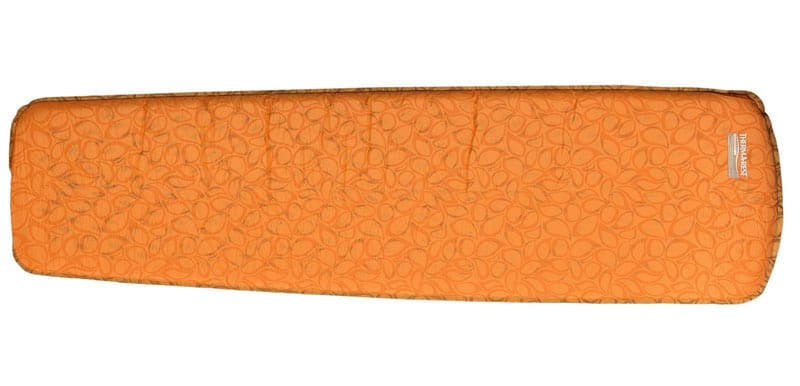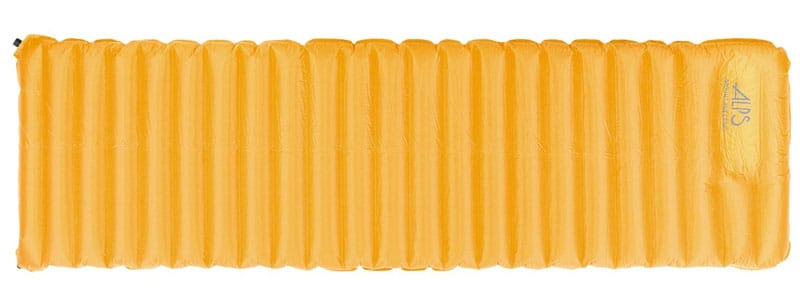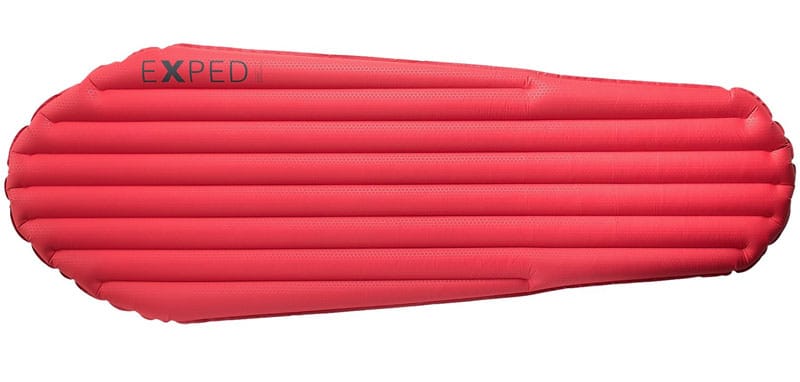
-
A sleeping pad (also called a sleeping mat or camping pad), serves at least one of two important functions, although many provide both. First, a sleeping pad should offer some level of cushioning between you and the hard ground. Without this, most people simply can’t sleep comfortably in the outdoors. Second, many sleeping pads also provide a layer of insulating material between you and the ground. In colder weather, a sleeping bag alone is often not enough to keep you warm. This is because the cold ground acts as a thermal heat sink, pulling warmth away from your body (even through your sleeping bag). In fact, most sleeping bag temperature ratings are only applicable when combined with an insulated pad. Unless you only plan on camping out on the warmest summer nights, you should definitely consider choosing an insulated sleeping pad.
-
Closed-Cell Foam Sleeping Pads

Made of soft, lightweight closed-cell foam, this style of sleeping pad provides moderate to good insulation (R-value) from the cold ground. Ideal for camping and backpacking, foam sleeping pads like those offered by Therm-a-Rest often have a textured surface for additional comfort and traction. For storage and transport, closed-cell foam sleeping pads typically fold up into a rectangular package. This design is bulkier than inflatable designs, so most backpackers must strap their closed-cell foam pads to the exterior of their backpacks. Foam pads also don’t offer as much cushioning compared to self-inflating and inflatable pads. On the plus side, these pads are very budget-friendly. Many models range from about $15 to $30.
- Ideal for: Cold weather, back sleepers, tight budgets
- Not ideal for: Side sleepers, people who need extra cushioning
Self-Inflating Sleeping Pads

Created by surrounding open-cell foam with air-impermeable fabric, self-inflating sleeping pads are equipped with a two-way valve that allows air to be squeezed out when the pad is rolled up (thus saving space during transport). In order to keep the pad from re-inflating, the valve should be kept closed. To deploy the pad, simply open the valve and unroll the pad. As the foam expands, it will draw air back into the foam until the sleeping pad has returned to its original, uncompressed shape. Because they’re created using open-cell foam, self-inflating sleeping pads provide good insulation from the cold (moderate to high R-value). They also provide better cushioning compared to most closed-cell foam pads, but often less cushioning than many inflatable pads. The biggest drawback is that self-inflating pads tend to be the heaviest option. They’re also more expensive than closed-cell pads, typically ranging from about $30 to $150 or more.
- Ideal for: Cold weather, back sleepers, side sleepers
- Not ideal for: Anyone on a tight budget
Non-Insulated Inflatable Sleeping Pads

Like a balloon, inflatable air pads must be inflated manually, either by using a pump or by physically blowing air into the mattress. Depending on the design, inflating this type of mattress by mouth can be challenging. Luckily, compact pumps are available in both manual and battery-operated models. Non-insulated inflatable pads are easily among the lightest sleeping pads available. When empty, they will compress down into a very compact package, sometimes barely larger than a one-liter bottle, making these ideal for ultralight backpacking. These pads also tend to offer even more cushioning than self-inflating pads. However, without the addition of insulation or a reflective barrier, inflatable sleeping pads provide minimal insulation from the cold ground (low R-value). Prices for non-insulated inflatable sleeping pads vary widely depending on the size and quality, but a good one will typically cost between $50 and $100.
- Ideal for: Warm weather, back sleepers, side sleepers, ultralight backpackers
- Not ideal for: Cold weather
Insulated Inflatable Sleeping Pads

Want an inflatable air pad that will help keep you toasty in colder conditions? Look for a three-season or four-season model with a thermal-reflective barrier on the inside, built-in thermal insulation, or both. Depending on the design and materials, insulated inflatable sleeping pads can be quite warm (moderate to high R-value) and are still typically lighter and less bulky than many self-inflating pads. The warmest four-season models may even include down insulation on the inside. The biggest drawback to this type of pad is cost, as insulated air pads frequently fall into the $100 to $200+ range.
- Ideal for: Cold weather, back sleepers, side sleepers, ultralight backpackers
- Not ideal for: Anyone on a tight budget
-
Put simply, R-value is a rating of thermal resistance. The higher the R-value of a sleeping pad, the better it will insulate against the cold. Although there is no industry standard for testing R-value, some companies have created their own standardized testing procedures. Therm-a-Rest, for example, measures sleeping pad R-values in a specially built cold chamber that is maintained at 39°F. Inside the chamber, Therm-a-Rest technicians place a mattress in between two metal plates. One of the plates includes a special sensor that is kept at a constant temperature using electrical current. If a pad provides good insulation, it will keep that plate warmer, therefore requiring less electricity to maintain the temperature of the sensor. Conversely, a mattress that provides less insulation will require more energy to maintain the temperature of the sensor. The amount of energy used can be inserted into an equation resulting in an R-value between zero and six. Check out the table below to see how Therm-a-Rest ranks R-values:
R-Value Best Use 0 - 2 Summer 2.1 - 3.2 Three-Season 3.4 - 5.6 Four-Season 5.7+ Extreme Cold Keep in mind that the R-values of other manufacturers may vary slightly depending on their individual testing methods and standards. However, this chart should still serve as a good baseline for most sleeping pads. If we include an R-value in the product specs, it will be the value provided by the manufacturer. Some companies may provide a temperature range instead of an R-value.
-

In order to get a good night’s sleep, you’ll need a sleeping pad that fits you. It may not be a problem if the pad you buy is too large, although you’ll be carrying extra weight, which obviously isn’t ideal for backpacking. If your pad is too small, on the other hand, you could be in for some uncomfortable nights. As you shop for a new pad, be sure to consider both length and width. Sleeping pad lengths are often similar to sleeping bag lengths. Many pads are available in both regular and long sizes, although other sizes may also be offered.
Obviously, knowing your height makes it easy to determine your ideal sleeping pad length. As for width, that will depend on your size and what kind of sleeper you are. Average-sized people are often comfortable with a standard width of about 20 inches. Larger individuals and people who like to spread out more when sleeping may be more comfortable with a wider pad. Some pads are also available in widths designed for two people. Just keep in mind that if both people like to spread out when sleeping, an air pad designed for two may not be ideal. Two individual pads might provide more room. Finally, if you’re camping out underneath a canopy, be sure to factor in the floor dimensions of your tent. Should you opt for a pair of wide sleeping mats, make sure they’ll both fit inside your tent before you’re miles from civilization.
Sleeping Pads for Kids
Several companies offer smaller camping pads designed specifically for kids, which are lighter, smaller and less expensive than comparable adult models. Some kids’ inflatable sleeping pads also feature protruding side baffles which act like rails to keep children from accidentally rolling off during the night. This is a handy feature for younger children who aren’t used to sleeping on an air pad. For older children, consider choosing an adult sleeping pad that they can grow into. This will save money in the long run and will provide a pad the child can enjoy for many years to come.
-
How to Wash a Sleeping Pad
Just like your sleeping bag, you should always air out your pad after every trip, allowing it to dry out completely before storing it. This will help prevent mold, mildew and funky odors from forming. If your sleeping mat gets really dirty or malodorous, you can scrub it down with warm water, mild dish soap and a washcloth. Be sure to rinse thoroughly. Also, make sure any valves are closed beforehand to avoid getting moisture inside the pad. Always line dry your sleeping pad in a shaded location away from direct sunlight (extended exposure to UV rays can weaken the materials). Never machine wash or machine dry a sleeping pad.
How to Store a Sleeping Pad
Inflatable air mattresses and closed-cell foam pads can simply be stored rolled up or folded and tucked inside a stuff sack. For self-inflating pads, it’s a good idea to store these unfolded and loosely rolled up (with the valve open), rather than fully compressed. If you store your self-inflating pad fully compressed for long periods of time, it may eventually prevent the foam from fully rebounding back to its original shape (thus diminishing the cushioning benefit). In other words, open-cell foam may start to loose its “springiness” over time when left in a compressed state. The same holds true for sleeping bags: Always avoid storing them inside a compression sack for long periods of time. Instead, use a larger storage bag.